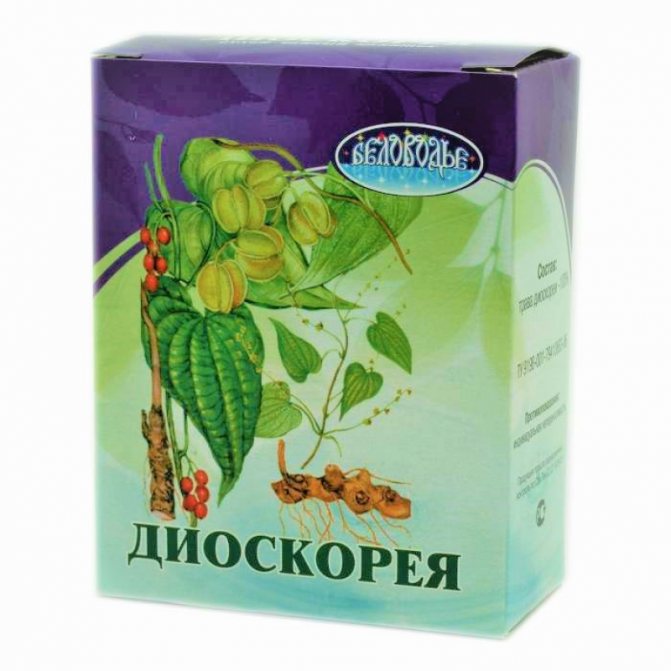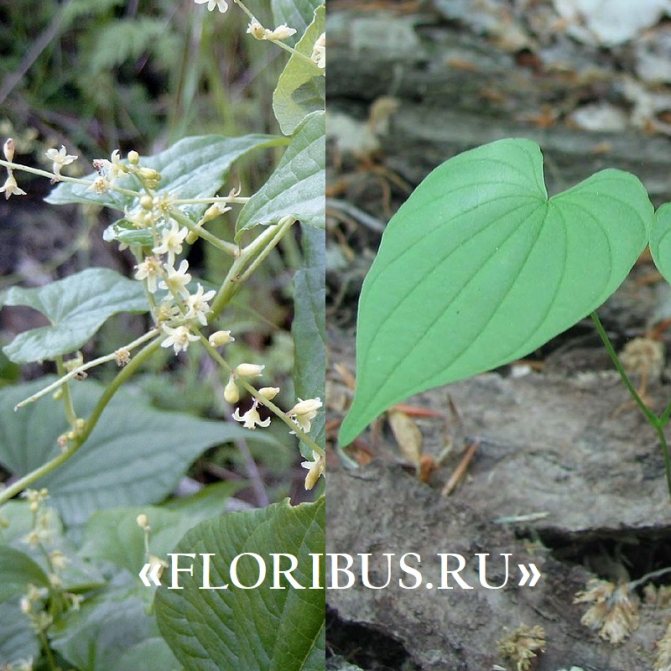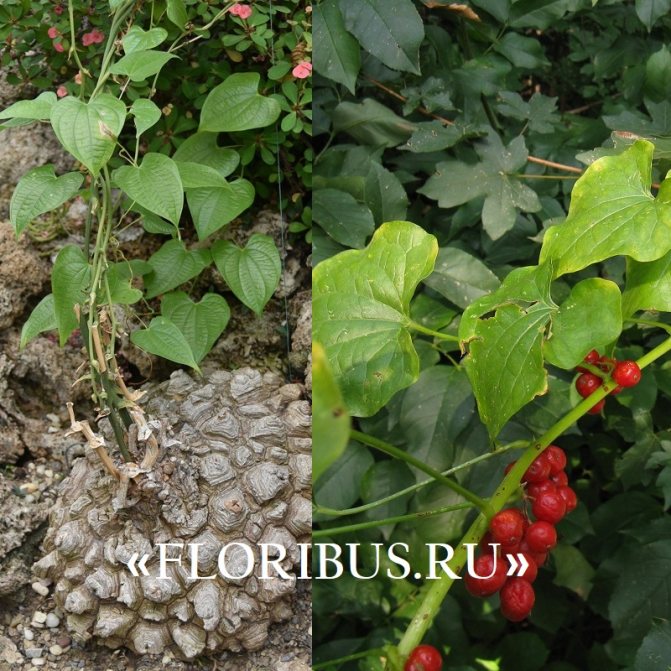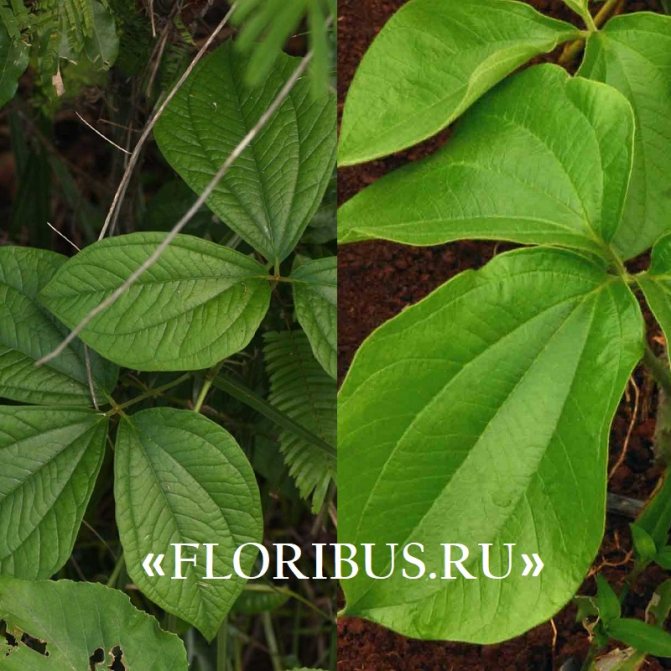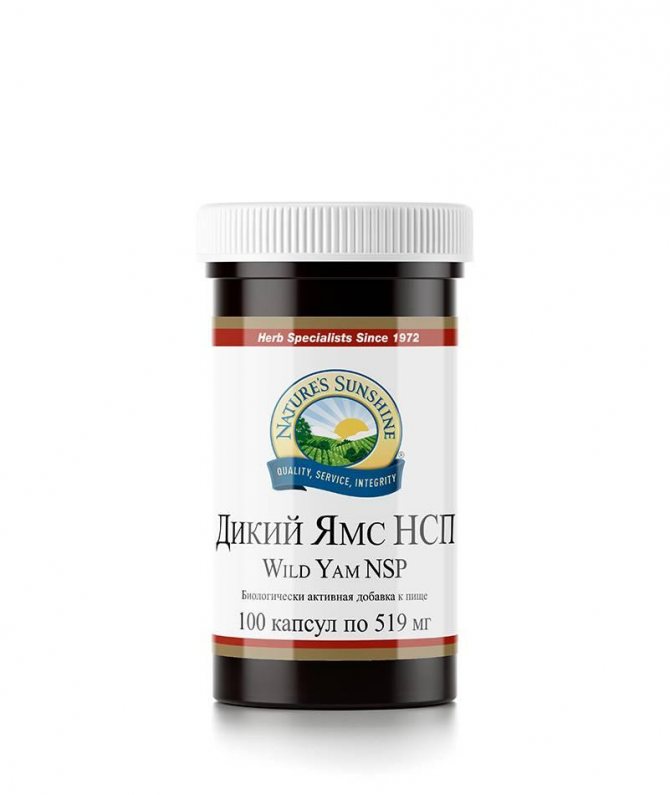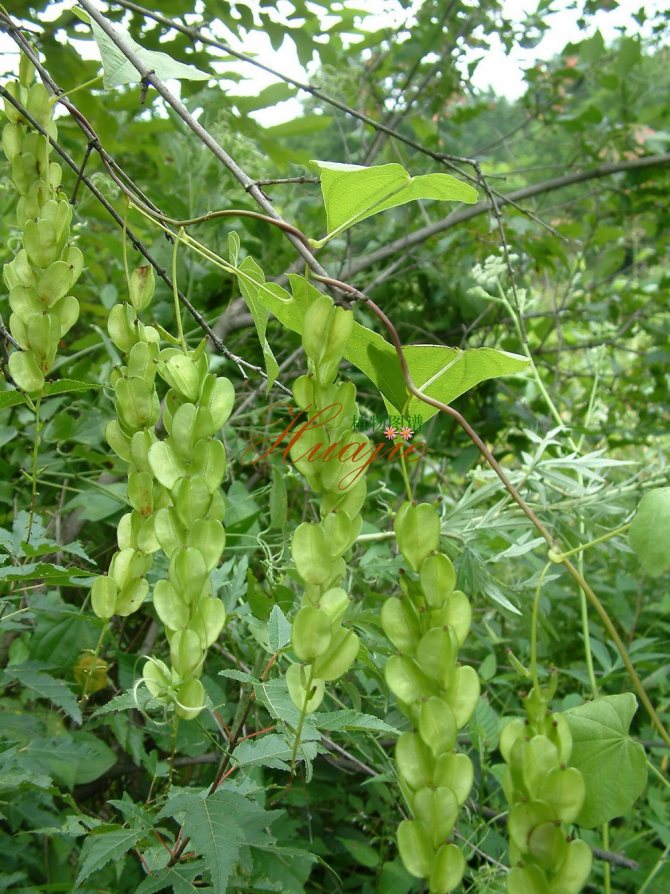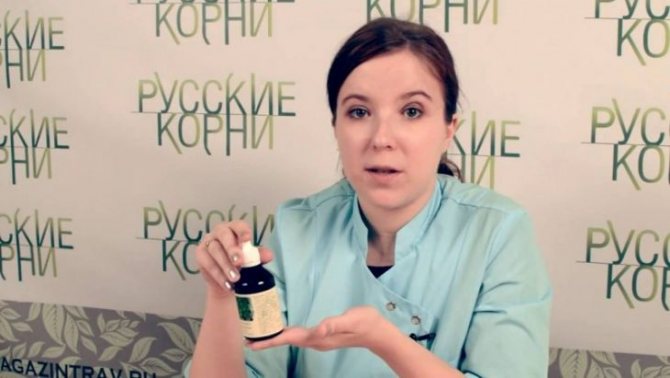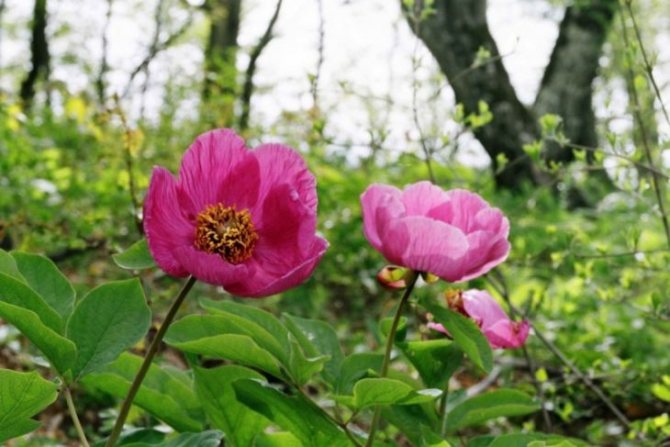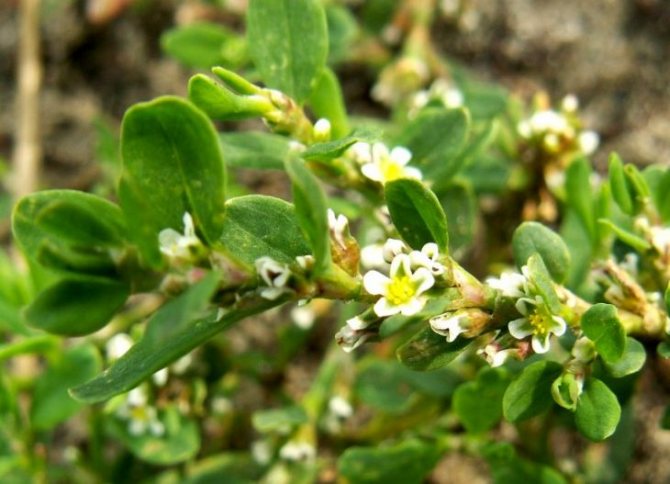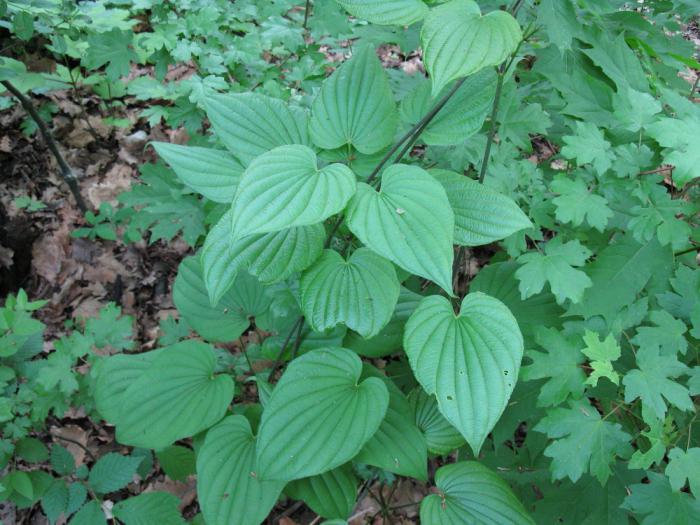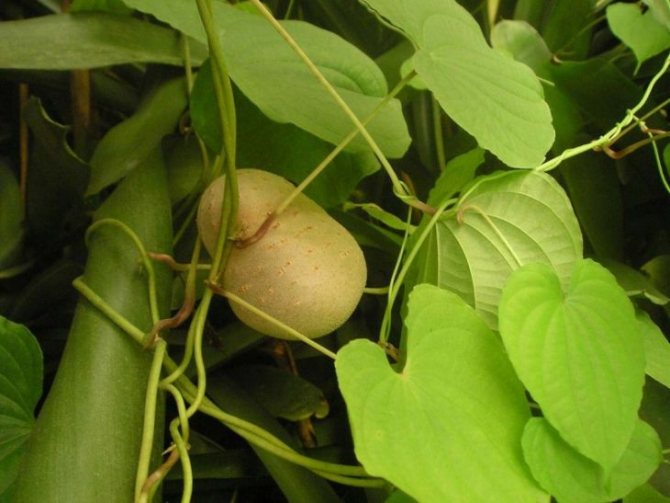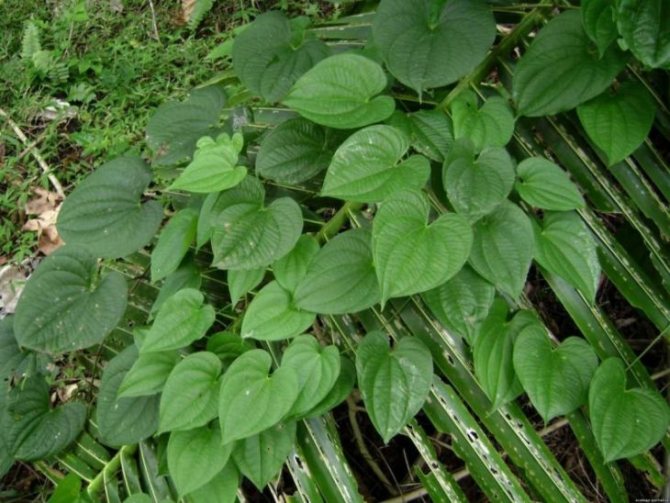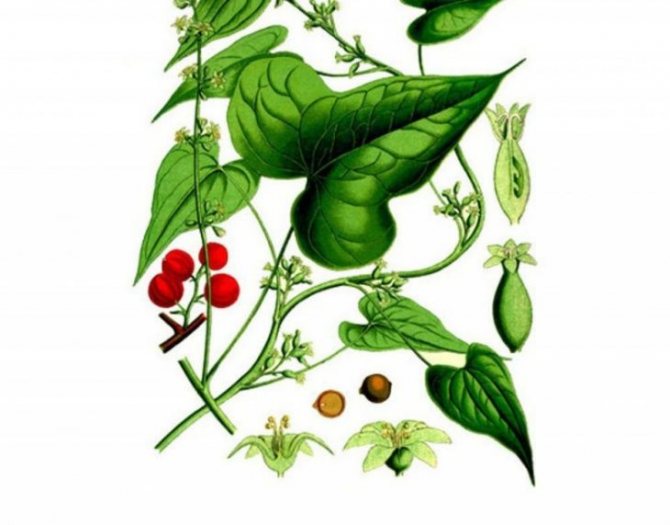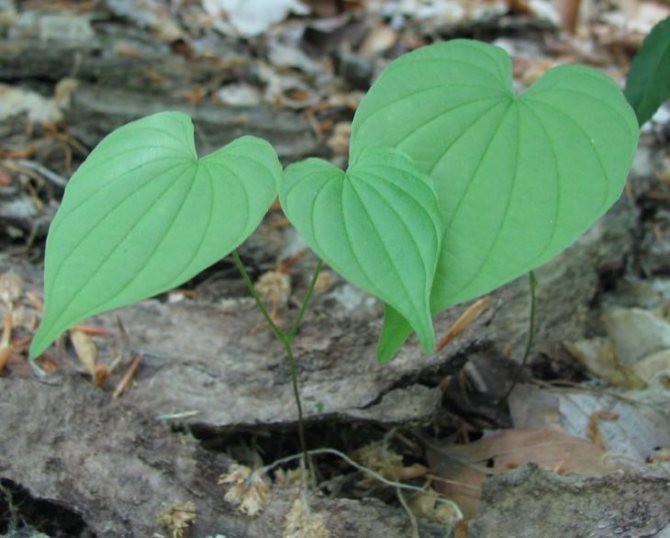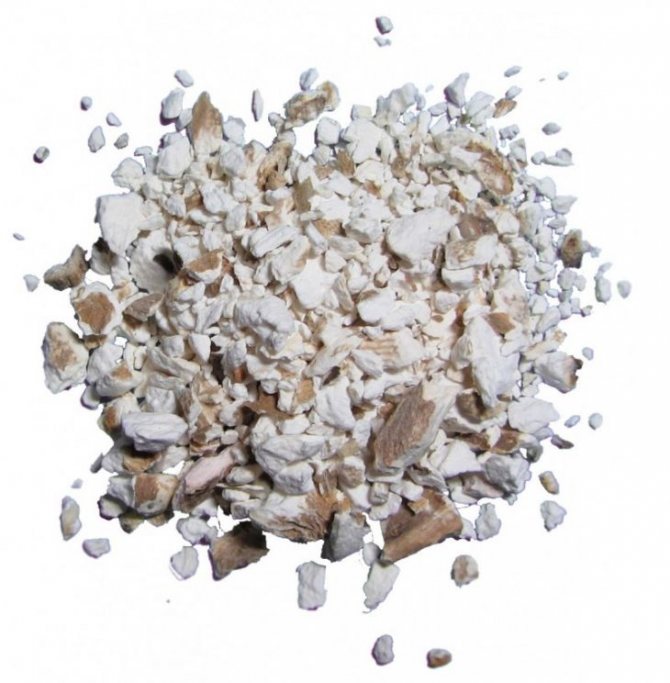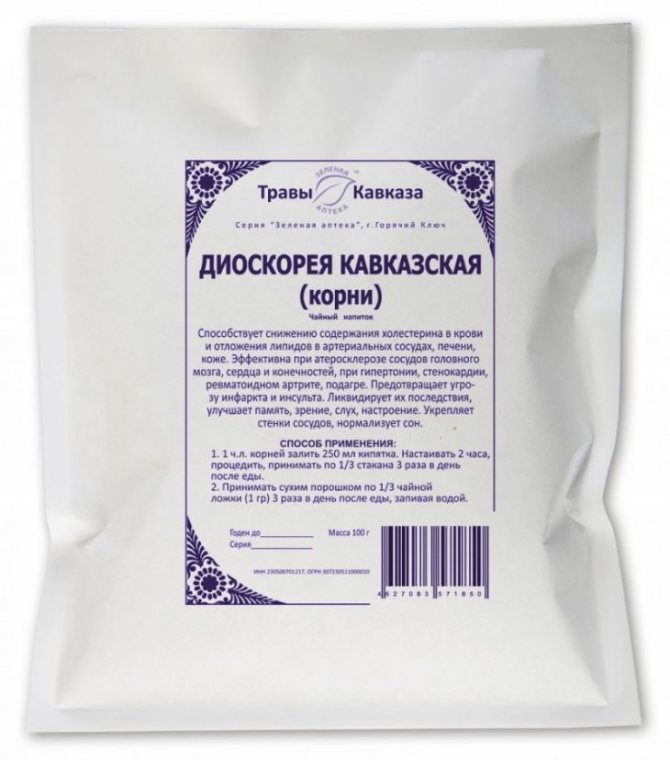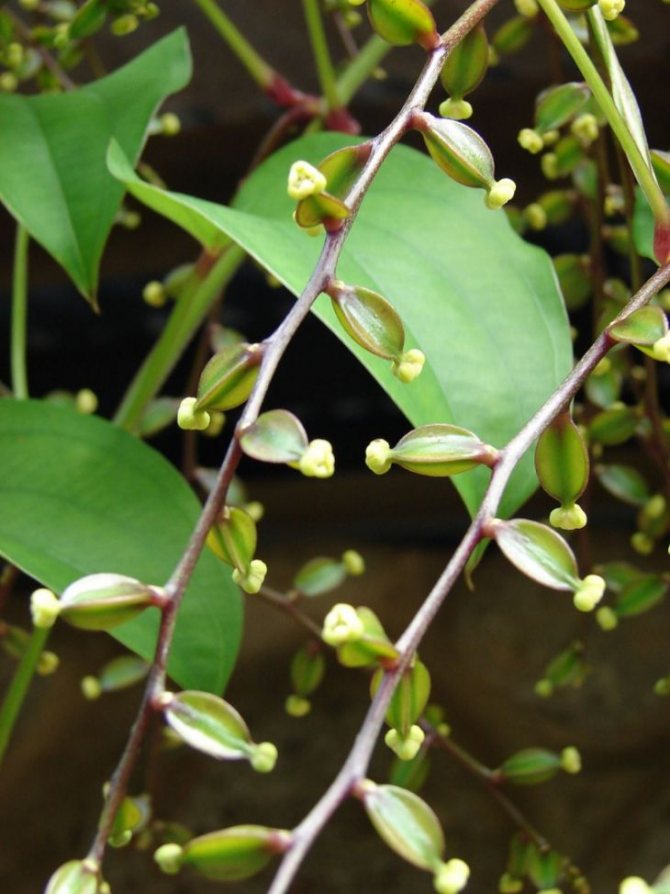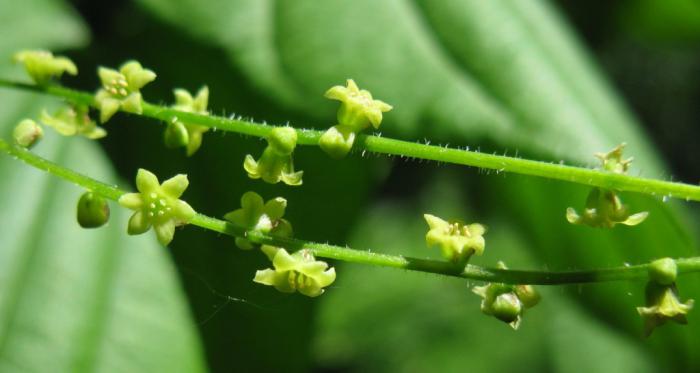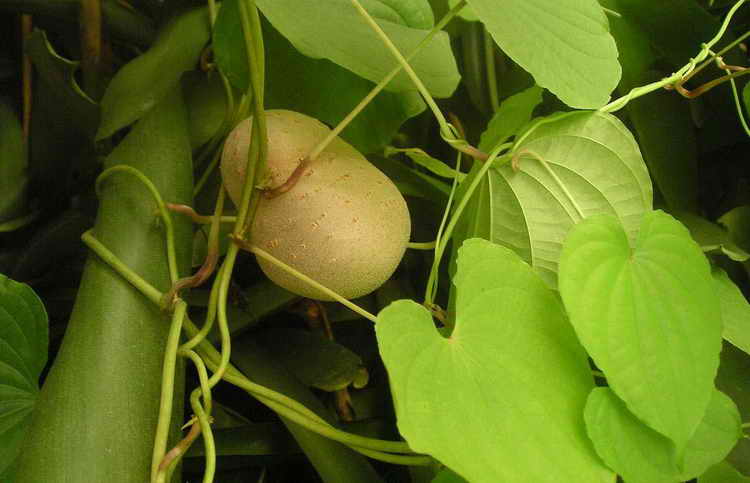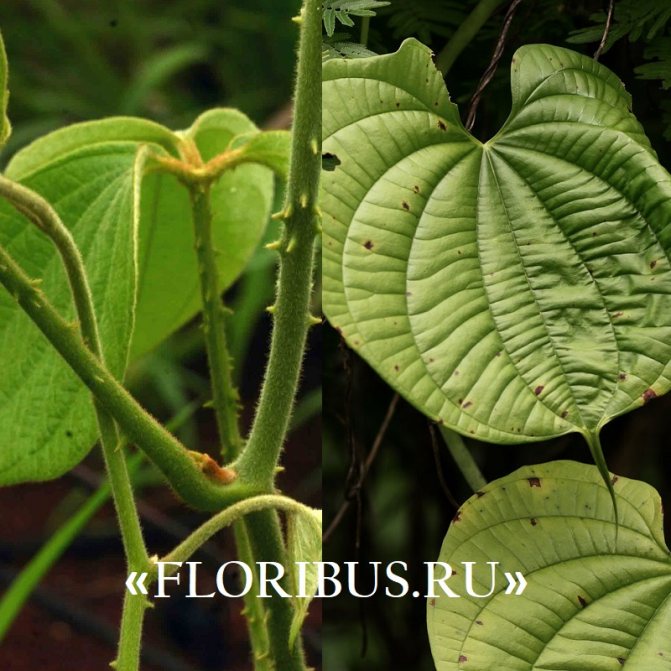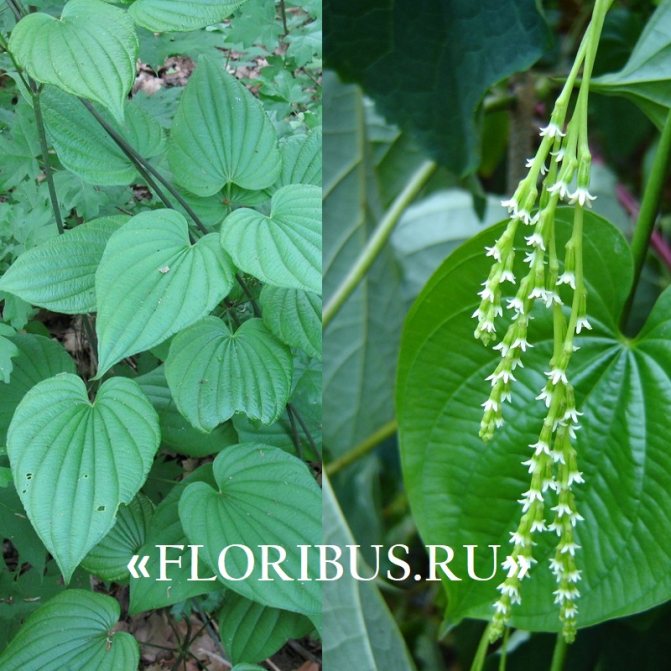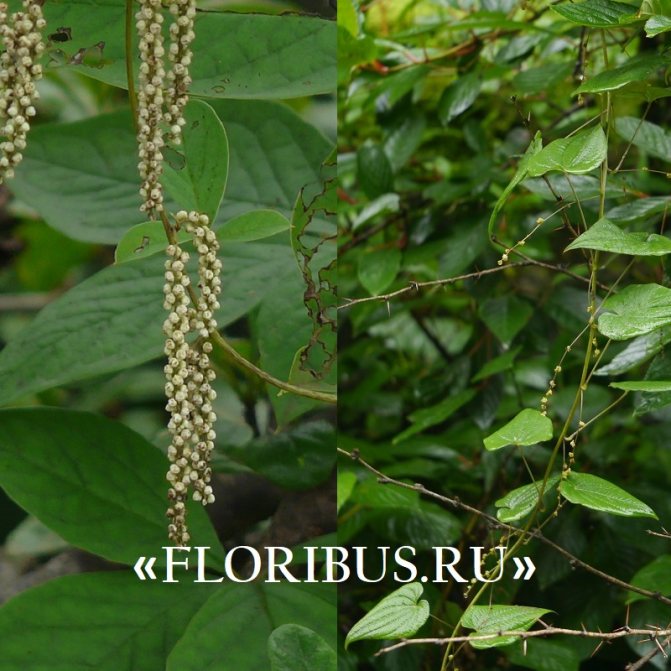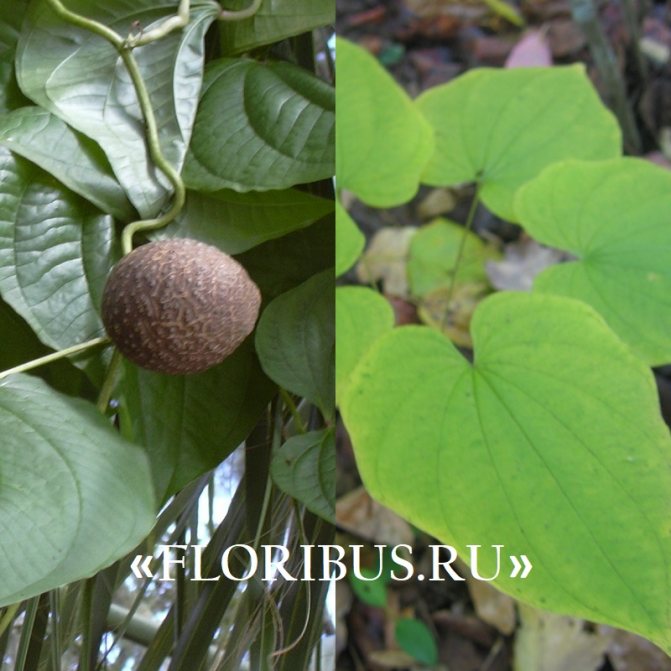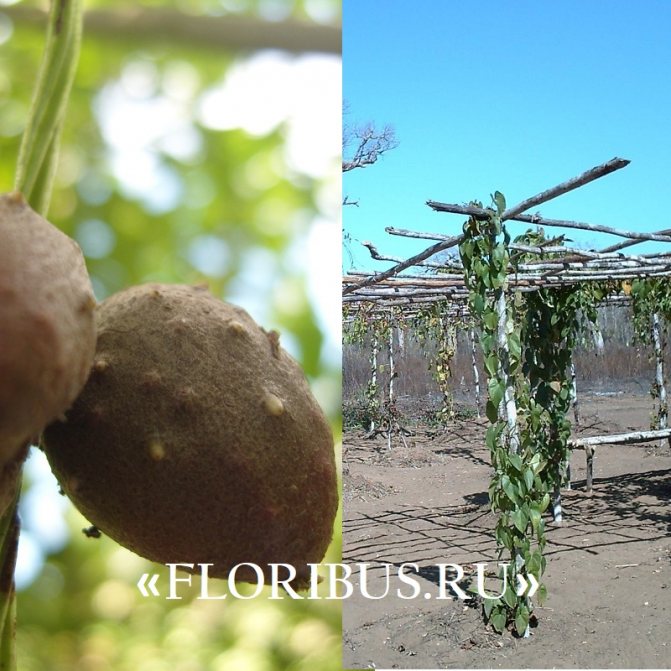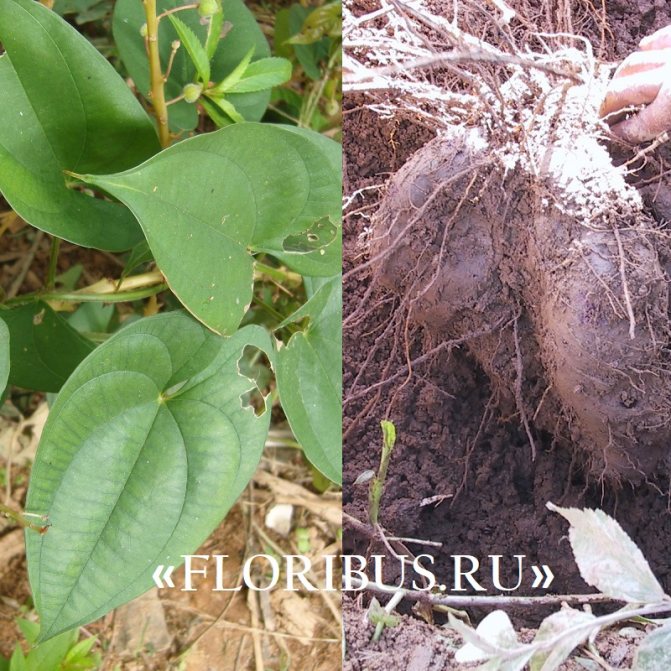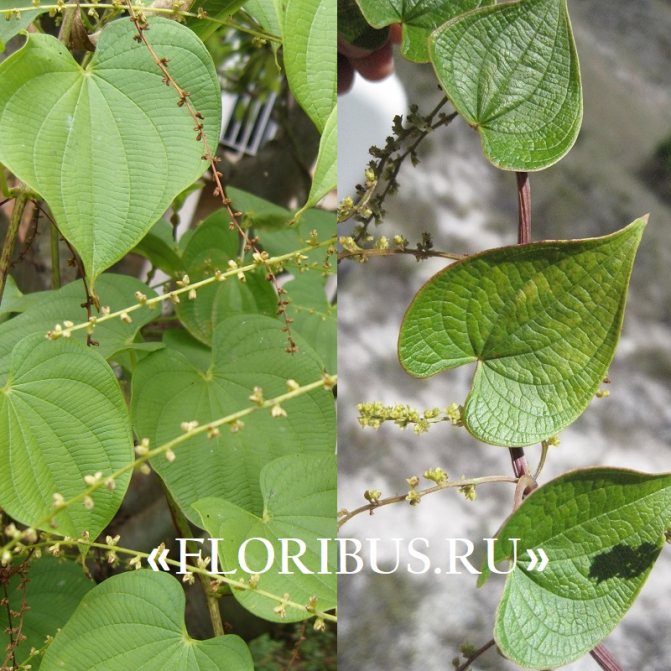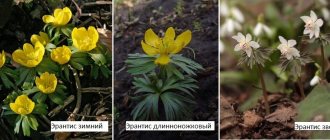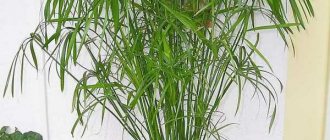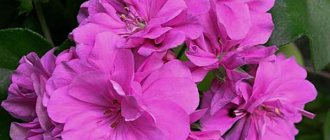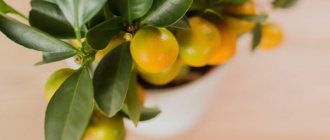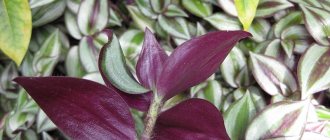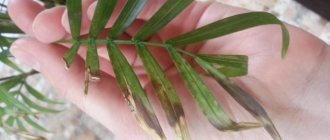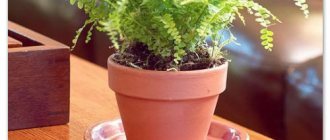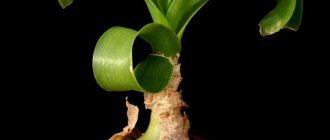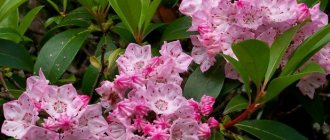Description
Dioscorea are perennial herbaceous vines. The underground part of the plant consists of a rhizome, which can unite one or more tubers covered with thin roots. Stems of old shoots, as a rule, are braided to the left or to the right (in different species), rarely erect or creeping, often with spines at the base. In the axils of the leaves of plants of some species, nodules develop. Young reproductive shoots can be pubescent.
Leaves are opposite, alternate, whole, lobed or articulated. Their base is often heart-shaped. The veins coming from the point of articulation with the stem diverge along the width of the leaf, then gather to the top. Plants are dioecious, but rudimentary male and female parts may be present on the same plant. Inflorescences are simple or complex, usually drooping, spike-shaped or racemose, male and female flowers are inconspicuous, small, single or paired.
The fruit is usually a dry three-celled capsule, dry and opening when ripe, rarely fleshy berries. Each nest contains 1-6 flat seeds with one or more wings.
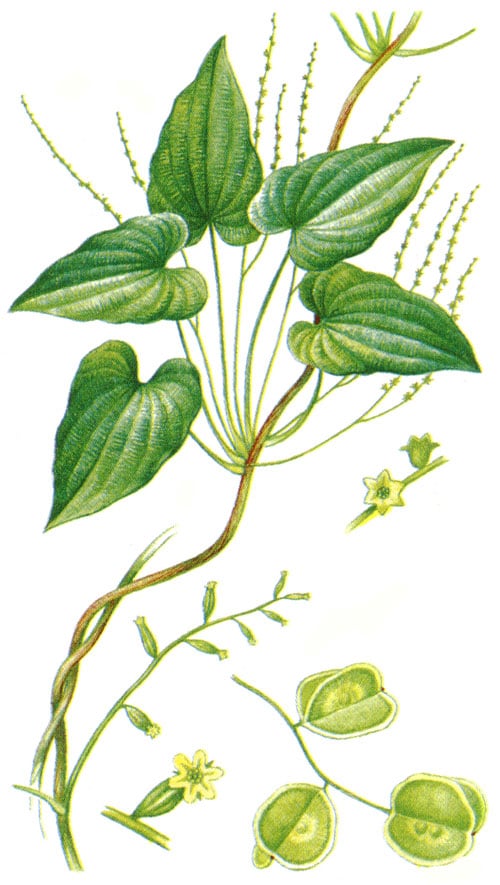
The structure of the Caucasian village
Contraindications for use
Before starting self-treatment, you should study the contraindications for taking dioscoria:
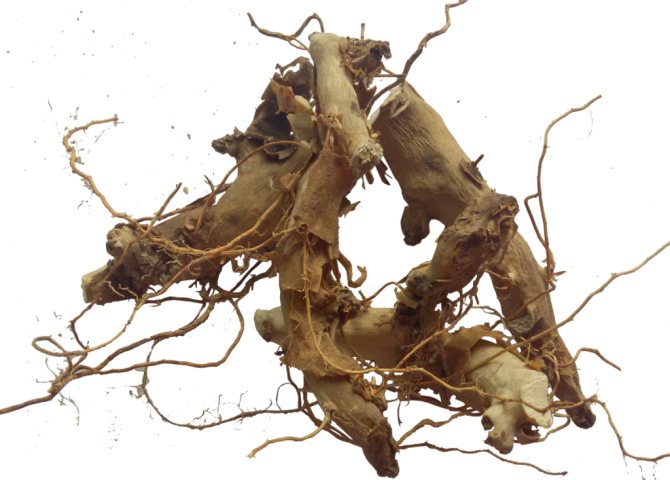

- hypotension - it is forbidden to take the plant under reduced pressure, so as not to aggravate the condition;
- bradycardia - the plant reduces the heart rate, therefore, with bradycardia, it cannot be taken;
- pregnancy and lactation;
- individual intolerance;
- ulcer and gastritis in the acute stage.
Side effects are rare, only with an increase in dosage without consulting a doctor and individual intolerance.
Dioscoria of Nipponskaya has proven to be effective in the treatment of hypertension, atherosclerosis and high cholesterol. But before starting treatment, it is recommended to consult a doctor in order to exclude contraindications and draw up a therapeutic regimen.
Popular types
More than 600 species are described in the genus. For cultivation in the middle zone of the country, the following are recommended.
D. Caucasian (D. сaucasica) - relict plants native to Western Transcaucasia. They grow on forest edges, clearings, among thickets of other shrubs, as they have weak competitiveness due to a low root growth rate - up to 7 cm per year. Perennial vines with thin stems, with the help of a support, capable of reaching up to 4 m. The rhizome is thick, located horizontally, with many dormant buds.
The lower leaves of D. Caucasian are matte, whorled, with a relief pattern of veins, oval-cordate, and the upper leaves are located opposite, sit on long petioles, pointed towards the apex, with a slightly notched edge.
Male flowers are small, yellow-green, inconspicuous, bell-shaped and form simple or slightly branched ears. Female flowers, similar in size and color, are arranged in simple ears or brushes.
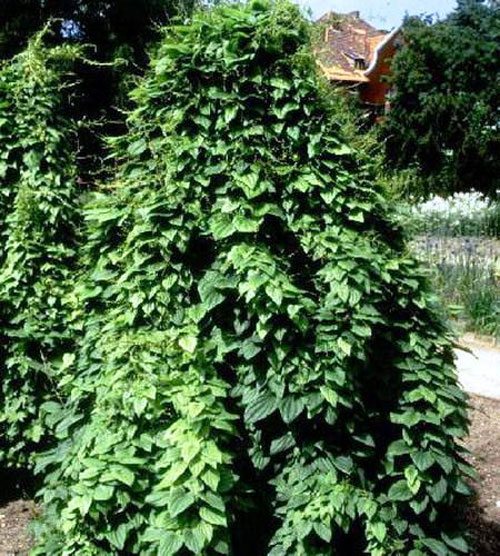

Dioscorea Caucasian
The fruit of the Caucasian village is a three-nested dry capsule with three membranous, oval wings. Plants of this type of dioscorea bloom in late May-July, and bear fruit in late summer or early autumn. Winter-hardy species in the middle lane.
In rhizomes d.Caucasian contains the largest percentage of saponins among other representatives of the genus - steroid glycosides with a wide spectrum of bioactivity, on the basis of which phytoestrogen diosgenin is obtained. In traditional medicine, diosgenin-based drugs are prescribed to women to synthesize progesterone, and they are also successfully used to treat atherosclerosis due to the ability of saponins to bind cholesterol.
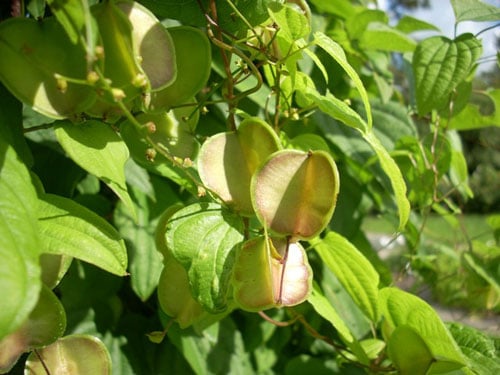

Leaves and fruits of D. Caucasian
D. nipponskaya (D. nipponica) - naturally grows in mixed forests of the warm temperature zone of China, Japan, Korea and the Russian Far East. The rhizome is horizontal, branched, cylindrical, more than 1.5 cm thick. The trunk is braided to the left, glabrous, green or reddish brown. Leaves are alternate, simple; petioles 10-20 cm; leaf plates are shiny, green, very variable in shape - from broad cordate to palmate-uneven, 3-7-lobed, pointed at the apex.
D. Balkan (D. balcanica) is the only species of the genus Dioscorea found in the Balkan Peninsula where it is endemic. In nature, it is endangered and protected. Height up to 2 m, in nature - up to 5 m. In winter, the stems of the Balkan village die off, but in spring young shoots develop.
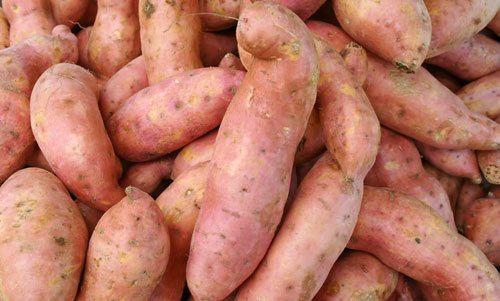

Yam tubers
Yams is the generalized name for some species of Dioscorea native to Africa and Asia, which are agricultural crops in their homeland and are grown for the sake of fleshy tubers. Cultural varieties have undergone significant selection, since wild yam is bitter. Tubers of all types of yams contain toxic substances that are destroyed by heat treatment.
In most regions of our country, yams do not grow, as they are demanding on heat and have a long growing season. However, the experiments of diligent gardeners can be crowned with success. J. Chinese (D. batatas) and J. Japanese (D. japonica) are especially promising due to their sufficient frost resistance.
Chemical composition
Rhizome and roots
plants contain flavonoids, saponins, and carbohydrates. The plant contains the largest number of nutrients during the budding period.
Pharmacognosy has been studying dioscorea for many years. This made it possible to find out that the beneficial properties of the plant are associated with the presence of steroid saponins in the composition, including:
- Protodioscin - increases testosterone levels, increases endurance and physical strength. Of particular benefit are athletes who need to build muscle mass.
- Protogracillin - has an anti-atherosclerotic effect, strengthens and increases the elasticity of joints.
- Dioscin - has anti-inflammatory and antitussive effects. Improves health, is used to prevent stroke and heart attack.
Photo gallery of views
How to collect and store
Dioscorea Caucasian is harvested only in places of cultivation, so it is unlikely that it will be possible to collect it on your own. Collecting rhizomes requires knowledge and a competent approach. An inexperienced collector may not just prepare the wrong plant, but also damage the rhizomes of perennial vines.
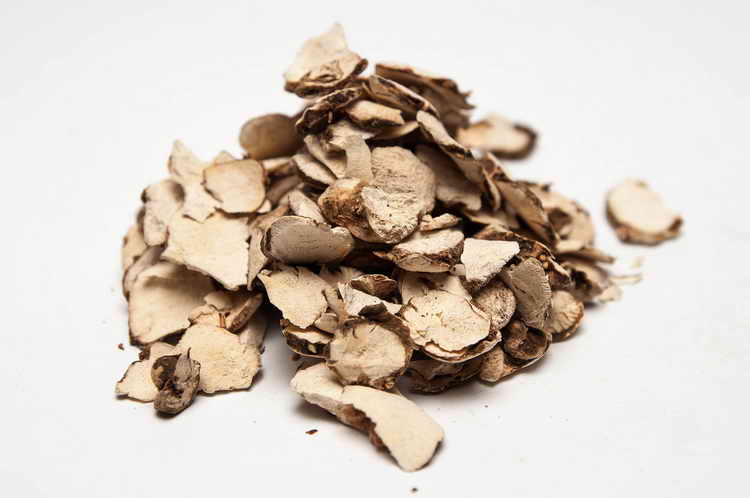

When buying a dry pick at a pharmacy or online store, you need to make sure that the rhizome is harvested and dried according to all the rules. A properly prepared collection is stored for up to 3 years. But willow loosestrife is found everywhere and is famous not only as a medicinal and ornamental plant, but also as an excellent honey plant.
Share in the comments if you had a chance to take tinctures or decoctions of Caucasian Dioscorea. What other uses of this vine do you know?
Growing and care
D. Caucasian is one of the most shade-tolerant climbing plants, therefore it can be planted in the darkest areas and corners of the garden.
Yams are inhabitants of tropical humid climates, but they are quite variable in requirements.Although they develop well in the sun, they tolerate partial shade without consequences, and, despite being moisture-loving, are resistant to short-term drought.
D. Caucasian is generally not demanding on the composition of the soil, but grows better on loose, fertile soils with neutral acidity. Too heavy clay soils restrict tuber growth and make harvesting difficult for yams.
For an adult Caucasian village, mulching the trunk circle for the winter is enough, and young plants require full-fledged shelter. Yam tubers are dug up in autumn, placed in containers with sand and stored until spring planting in a cool room.
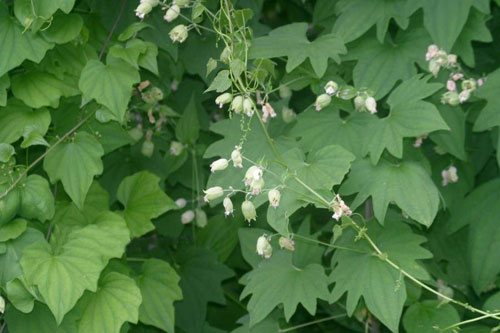

Dioscorea of Nippon
For all types of dioscorea, supports are needed to determine the direction of growth.
The recommended species are generally disease-resistant and are not disturbed by pests.
Beneficial features
The beneficial properties of the plant have been studied well enough. Dioscorea nippon contains saponins that remove harmful cholesterol from the body. This reduces the risk of developing atherosclerosis and other diseases of the cardiovascular system.
Another beneficial property of the plant is to lower blood pressure. Reception of dioscoria is indicated for hypertension as a means of prevention and main treatment at the initial stage. If the pressure rises to the level of 160 mm Hg. and above, the plant acts as an adjuvant therapy.
Dioscoria is popularly called the root of longevity for its ability to reduce the risk of stroke and heart attack. Also, the plant has a tonic and tonic effect on the body. It helps fight inflammation and infectious diseases.
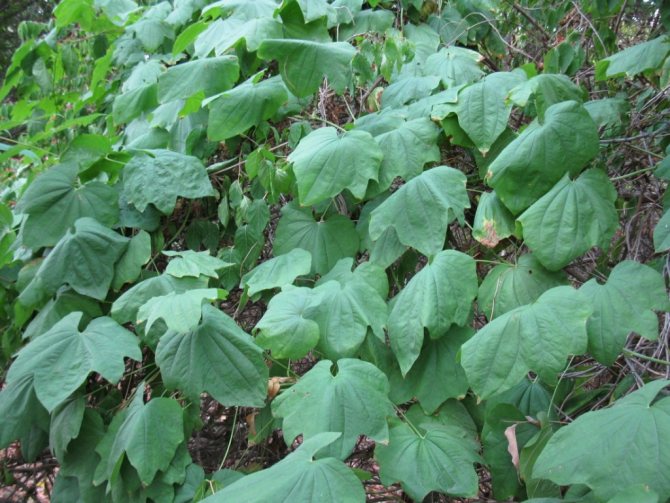

Which pathologies can you take medications based on the root of longevity:
- hypertension;
- hormonal deficiency;
- inflammation of various localization;
- stroke and heart attack;
- chronic fatigue;
- coronary artery disease;
- atherosclerosis;
- disorders of the gastrointestinal tract associated with secretory insufficiency.
In folk medicine, the plant is used to treat skin conditions. Ointments and compresses prepared on the basis of the root of youth are effective for cuts, eczema, dermatitis and other violations of the integrity of the epidermis.
Reproduction
Pollination of flowers occurs naturally in the presence of plants of male and female genotypes, and leads to the formation of hybrid seeds of known origin, therefore, it is of interest for use in breeding programs or for avid gardeners. By itself, reproduction by seeds looks ineffective compared to vegetative propagation methods, since dioscoreas grown from seeds can become full-fledged inhabitants of the garden only after 3-4 years.
D. Caucasian reproduces by dividing rhizomes. Delenki up to 15 cm long are cut and planted in the fall, after the end of the growing season.
Yams can reproduce by both seed and vegetative methods, but due to the difficulties with flowering, even in their homeland, sexual reproduction makes only a small contribution to the distribution of these species.
In yams, after ripening, rounded nodules are formed in the leaf axils, which are collected after they ripen and fall off the branches and stored until spring in a cool (up to 10 ° C) dark place. Nodules are planted in open ground in March - April, they tolerate possible frosts well.
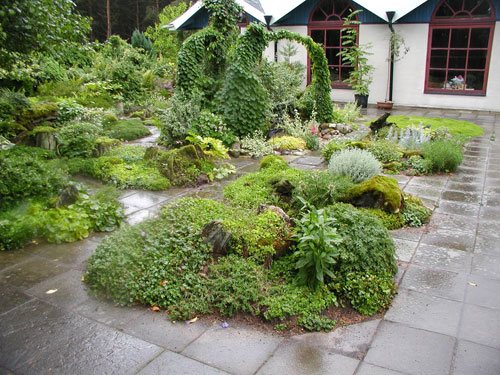

Arches braided by D. balcanica
Cooking recipes:
- Tincture. The most effective drug is tincture. The plant, during prolonged infusion, gives up the maximum of useful substances to the liquid, and alcohol helps them quickly penetrate the blood. To prepare the tincture, you will need 100 gr. dried and shredded plant roots
and 500 ml of vodka or diluted alcohol. Mix the ingredients in a glass jar, close the lid and remove for 2 weeks.After insisting, take 20 drops 3 times a day with water. - Honey infusion. 2 tbsp mix chopped dioscorea root with a glass of honey. Leave to stand for 3 days. Suck in a teaspoon in the mouth 3 times a day after meals.
- Broth. 1 tsp add crushed roots to 200 ml of water and put in a water bath. Boil for 20 minutes. Strain and take ¼ glass 3 times a day.
- Ointment. With atherosclerosis of the legs, you can use an ointment, which includes 2 tbsp. Dioscorea roots and 300 ml of pork fat. Melt the fat, mix with the plant and leave for 2 hours. Put in the refrigerator. Lubricate your feet 2 times a day.
- Tea. To make healthy tea, mix 1 tsp each. dioscoria and green tea. Brew with boiling water, leave to brew for 15 minutes. You can take 2-3 cups of this tea per day.
Use in landscape design
D. Caucasian, Nippon and Balkan are some of those wonderful climbing vines that gardeners should have at their disposal.
Plants are surprisingly versatile. Adding a vertical component to the landscape landscapes, they are able to hide the walls of buildings, garages, braid arches. Dark green foliage with interesting texture will provide dense shielding and add visual appeal to outdoor spaces. In addition, the Caucasian village has sufficient shade tolerance to brighten up the distant corners of the garden.
Procurement of raw materials
The roots and rhizomes of the plant are harvested as a medicinal raw material. It is believed that the most suitable for medicinal purposes are plants that have reached the age of 25.
The collection can be carried out from the end of April to the end of October. They do it as follows. The rhizomes are dug up, separated from the ground and the remnants of the stems, and then cut into pieces, washed with cold water and dried, spreading in a thin layer, in air or in dryers at a temperature not exceeding 50 ° C.
Dried rhizomes and roots of Caucasian Dioscorea have a bitter, slightly pungent taste, odorless. At the break, they are whitish, and the outside surface is light brown in color. Store ready-made raw materials for no more than 3 years in a ventilated area in paper bags, boxes or boxes.
Important: Wild yam belongs to the relict plants listed in the Red Book, therefore, only plants grown for this purpose specially in artificial conditions are currently used for medical purposes.
What properties does the plant have?
As pharmacognosy shows, Dioscorea Nippon is used to combat certain diseases. How the main substances of the rhizome - steroid glycosides - work have long been studied. Their most valuable action is anti-sclerotic. Many clinical trials have been cited, as a result of which scientists have found that steroid glycosides, in particular diosponin, can reduce the deposition of low-density lipoproteins and hypercholeterolemia in the arteries, liver, skin and cornea of the visual organs. Such substances are able to increase the ratio of compounds such as cholesterol and lycithin. Diosponin has a positive effect on the work of the cardiovascular system as a whole, allows you to lower blood pressure, as well as expand peripheral blood vessels. Preparations based on dioscorea nipponskaya have anti-sclerotic and diuretic effects.
Botanical classification
Synonyms
According to The plant list
for 2013, the synonyms of the species include [6]:
- Dioscorea canariensis Webb & Berthel.
- Smilax rubra Willd.
- Tamus baccifera St.-Lag.
- Tamus canariensis Willd. Kunth
- Tamus cirrhosa Hausskn. ex Bornm.
- Tamus communis basionym
- Tamus cordifolia Stokes
- Tamus cretica L.
- Tamus edulis lowe
- Tamus norsa lowe
- Tamus parviflora Kunth
- Tamus racemosa gouan
Contraindications and harm to shaggy dioscorea
The value of fruits and leaves of vegetables is divided into three groups:
- for women;
- for men;
- common pathologies of both sexes.
Chinese yam for the male body plays the role of a defender of the immune system. Its reception will prevent the development of cancer: skin, liver, thyroid and intestines.
Most of the indications are aimed at helping both sexes:
- Strengthening the nervous system: sleep is normalized, fatigue and irritability go away.
- Improving brain activity: enhancing the properties of memory.
- Strengthening blood vessels: normalizing blood composition.
Different peoples use shaggy dioscorea, transmitting data on its healing properties from generation to generation, but the approaches to use are not always the same:
- America. Against a strong cough.
- China. To restore the functions of the kidneys and spleen.
- Areas where there is no agricultural purpose for growing fruit. Creation of means against bites of poisonous insects and snakes.
- Africa. Treatment of cardiovascular diseases.
Regular intake of roots in food will return a person to activity, remove signs of causeless fatigue, bone pain.
Women use root vegetables and leaf tinctures to relieve pain during menstruation. One small vegetable can help relieve pain, cramps, and cramps.
- Diaskorin, contained in the fruit, activates the contraction of the muscles of the uterus, there is a positive improvement in sexual performance. Such abilities attract frigid women, patients with decreased sex drive.
- The phytoestrogens in the roots regulate hormonal levels. They help to control the frequency of monthly cycles, the menopause will shift, there will be protection from uterine atrophy.
Found their application of funds from Dioscorea shaggy in cosmetology and dermatology:
- conjunctivitis;
- eczema;
- psoriasis.
In Mexico, women use the plant as a contraceptive, contraceptive, with the likely threat of premature birth, against toxicosis accompanying pregnancy.
The use of funds from a wild medicinal plant is not allowed to everyone. There is a certain list of diseases when taking it becomes dangerous and causes complications or side effects. Female pathologies:
- uterine fibroids;
- ovarian oncology;
- mammary cancer;
- endometriosis.
For men, the funds are contraindicated in case of a disturbed imbalance in the protein content in the body. The risk of developing blood clots increases.
Contraindications for taking alcohol tincture:
- gastritis;
- pancreatitis;
- hepatitis;
- ulcer;
- cholecystitis;
- stones in the gallbladder.
Such warnings are associated with the action of the drink in the intestines, the tincture irritates the gastric mucosa.
The root vegetable is not approved for use during pregnancy and lactation. The plant provokes premature birth, changes the development of the fetus. When breastfeeding, the baby is at risk of deviations in health, but research by scientists does not have scientific evidence of the effect on the newborn's body. The risk often becomes unjustified, it is better to choose proven products that are safe for children.
DETAILS: Propolis Oil in Gynecology
The main situations when it is recommended to buy wild yam are: • menopause; • premenstrual syndrome; • sleep disturbance; • increased nervous tension; • atherosclerotic vascular lesions; • increased blood cholesterol levels; • excess weight; • impaired blood circulation;
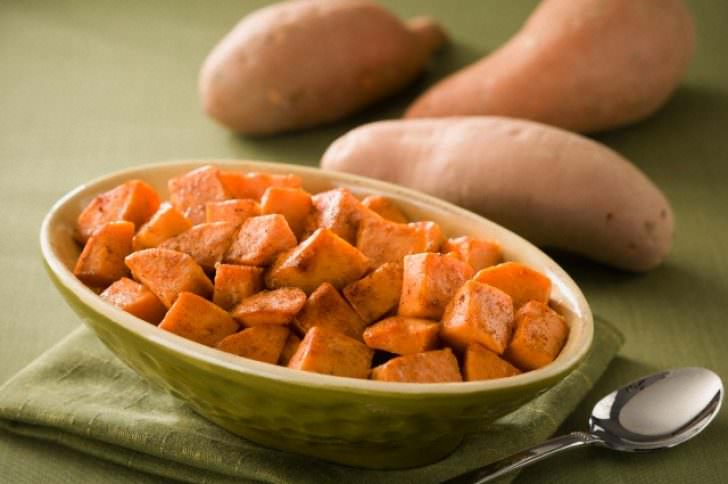

• high blood pressure; • inability to get pregnant due to hormonal imbalance. There are contraindications in this case. These include: • lactation, because it is not known how the supplement will affect the child's condition; • taking anti-inflammatory drugs, because some information confirms an increase in the damaging effect on the gastric mucosa; • taking oral contraceptives - hormonal imbalance may occur; • endometriosis, ovarian and uterine cancer.
As for pregnancy, doctors' reviews on this matter differ. Someone considers wild yam useful in this case and advises buying a product in order to drink a course, someone recommends minimizing the use of any additives, because it is not known how they will affect the baby.As for the instructions for the drug, here pregnancy refers to contraindications.
Dioscorea Caucasian: medicinal properties
This plant is considered medicinal. It is used to treat various diseases. An excellent remedy is preparations made on the basis of the rhizome of Caucasian Dioscorea. The root is best harvested in early fall or spring. Raw materials should be thoroughly dried, after which they should be stored for no more than three years. Dioscorea infusions and decoctions are immunomodulatory, soothing, tonic, choleretic, diuretic.
The composition of this plant contains various chemical components, including steroid glucosides - with their help you can cope with excess cholesterol. Dioscorea also contains starch and fat.
Comments (1)
"Online edition" Woman '(VumansDey.ru) "Media registration certificate EL No. FS77-67790, issued by the Federal Service for Supervision of Communications, Information Technology and Mass Media (Roskomnadzor) on December 13, 2019 16+.
Founder: Limited Liability Company "Hirst Shkulev Publishing"
Editor-in-chief: Dudina Victoria Zhorzhevna
Copyright (c) Hirst Shkulev Publishing LLC, 2019.
Any reproduction of site materials without the permission of the publisher is prohibited.
Contact information for government agencies (including for Roskomnadzor):
Dioscorea nipponskaya is a medicinal plant that is a vine. It grows in the Far East and is extremely rare. The plant has many beneficial properties and is used to treat certain diseases. The most important thing is to collect the raw materials correctly and on time, as well as prepare a preparation based on it. What is this plant and what effect does it have?
What components are included in wild yam
The most important component of wild yam is diosgenin, a precursor of the steroid hormones progesterone and cortisol. The substance is characterized by moderate estrogenic activity, often used in laboratories for the production of steroid drugs. In addition to diosgenin, the composition contains the following components: • vitamin C; • vitamin B1 or thiamine; • saponins; • glucose; • alkaloids; • starch.
The listed components also have a beneficial effect on the human body, normalize numerous processes that have been disrupted for any reason. It is worth noting that you can buy wild yam as a complex supplement, where, in addition to it, there will be other active ingredients that expand the area of action of the drug and increase its effectiveness.
DETAILS: Hirudotherapy gynecology Perm
Cream
Dioscorea is a unique herb that is found in some contraceptives, and the creams in which it is found help to heal eczema. Decoctions and infusions are the best antirheumatic, antispasmodic, antipyretic, anti-inflammatory drugs. This plant is a godsend for women in the premenstrual period. Medicines prepared on its basis dilate blood vessels, relieve convulsions and spasms.
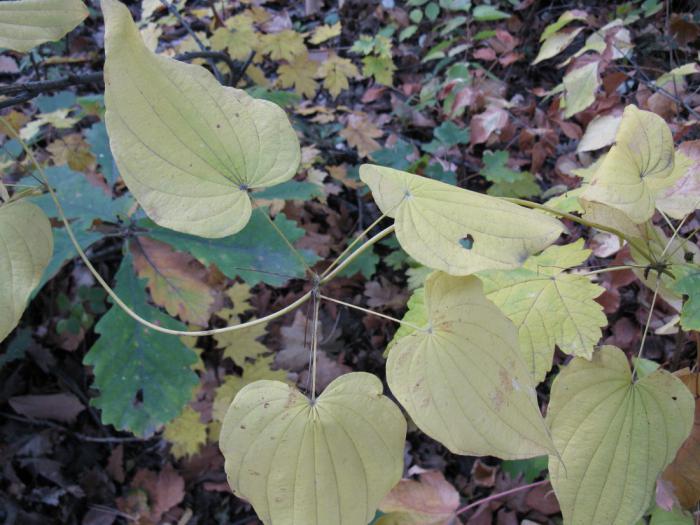

Dioscorea is rich in phytoestrogens, including diosgenin. If infusions and decoctions from the root are used during menopause, you can protect yourself from diseases such as osteoporosis, and also improve the functioning of the sex gland. With the help of drugs that include this plant, cystitis and other inflammatory processes in the urinary tract can be cured.
Dioscorea Japanese
This species is distinguished by the shape of the leaves, as well as the longer shoots and the width of the stems of the vines. It is distributed in the south of the Far East.The rest of the relatives are similar: the number of plants is steadily decreasing, therefore they are also in the Red Book, people are trying to cultivate them in order to be able to obtain valuable medicinal raw materials without harming nature.
Plant-based preparations help to cope with:
- atherosclerosis by lowering cholesterol levels;
- headache;
- rapid fatigue.
Among the positive properties, it is also necessary to mention:
In addition, dioscorea products reduce the level of blood clotting.
Nippon riddle
Immediately, I note that Dioscorea is an extraordinary plant, like the Greco-Roman doctor Dioscorides, whose name it is named after. Everything in it speaks of a foreign origin. The leaves, although they cannot be called exotic, are unusual for central Russia. An experienced glance will note the parallel venation, which is rare in our plants, but so characteristic of the entire family of Dioscoreae. The leaf shape is also typical and recognizable. And if you dig into the soil, you will find a rather short tuberous thickened rhizome, also very characteristic of Dioscoreae.
Dioscorea has been present in our garden since about 1989-1990, and all this time it has been growing in one place. The site was chosen in accordance with the recommendations that were available in the literature - semi-shady, with permeable, humus-rich soil.
Liana took root without any problems, but was in no hurry to grow. At first, it developed without support, but then it found it in the person of actinidia growing nearby, and began to climb its lashes every year. At first, not higher than a meter, but with age, to a height of about 2.5 m. The fact that Dioscorea was developing could be judged by the number of shoots. At first, he was only one, then, when the rhizome spread 70 cm in breadth, there were more than a dozen of them. By the way, they are very thin, with a match, grow in one thread, practically without branching, and winding around the supports clockwise.
From 10-12 years old, the liana began to bloom. Nondescript, greenish in color, and very small flowers, as one would expect, fell off without setting the fruit. This continued until the age of 17-18, from which the fruits appeared - three-lobed capsules. But they didn't ripen. From year to year, the boxes became larger, but as soon as they were opened, it was clear that nothing was tied inside. This continued until 2012, when the fruits reached unusually large - about 2 cm in length and size. And as already mentioned, they set up viable seeds.
But botanists, and this is not difficult to verify, (Life of Plants, Volume 6, p. 232) consider the vine to be dioecious. And where, one wonders, has gone to her dioeciousness ?! And was it even at all, maybe this plant is still monoecious? And if this plant was originally female, how was it fertilized? In general, here's a question for you, associate professors with candidates: what happened?
Personally, I have two versions of the explanation for what happened. First, dioscorea is a polymorphic species, and can be both monoecious and dioecious. Second, in the absence of a pair, dioecious dioscorea can be reborn into a monoecious, but this happens only at a sufficiently mature age of the vine. This phenomenon, by the way, is not uncommon. Also, for example, dioecious Arizems behave.
I myself did not sit idly by and, armed with a 10x magnifying glass, undertook my own investigation. It was found that the flower (corolla) of my dioscorea has six microscoric petals, opposite each of them a stamen sticks out, and in the center there is one pistil. It turns out that this liana still has a normal sexual orientation, or, more simply, is monoecious, like most flowering plants on earth?
After rummaging through the literature and thinking it over, I'm still more inclined towards the second version. And this is how it appears to me in its final form: - My Dioscorea was originally male.(It is known that in nature male plants are found much more often than female ones.) The structure of its inflorescence also indicates that the male plant is also racemose and rather long, while in female plants, according to descriptions, it should be compact. The flower of the male Dioscorea Nippon, in addition to the six stamens, has an underdeveloped pistil, or gynoecium. So, my Dioscorea's gynoecium developed into a full-fledged pistil with age, and she got the opportunity to fertilize and give ripe seeds.
Preparations with wild yam extract
The most popular remedies are dietary supplements. Their actions are broad in purpose: to improve health, preserve beauty and freshness, and prevent the development of various diseases. Food additives are offered in the form of dry powders, tinctures. A vaginal cream is suitable for solving gynecological problems. Supplements contain plant extract. The form of such preparations: dry powder, capsules, tablets and liquid solutions.
- Capsules. They are comfortable to receive. The medicinal extract is covered with a vegetable membrane, entering the body, it is quickly absorbed and produces the promised effect. Manufacturers of capsule products enhance their action with additional ingredients: E group vitamins, black pepper seed extract.
- Pills. The most common form of medication. The drugs do not fix the problem quickly, like capsules, but they are effective with the correct dosage and adherence to the prescribed course, the instructions will explain in detail the rules for taking.
- The extract-based cream is included in the complex of skin care products. Such formulations enrich the epidermis with useful microelements. The cream will support youth and health. Special developments of cosmetologists are recommended for daily care.
Other options for trade offers of preparations with wild fruit extract:
- The Saem emulsion for cleansing, reducing wrinkles, tightening contours.
- Vitamin complex NSP;
- Balancing cream;
- Serums for problem skin;
- Ampoule products for hair strengthening;
- Face masks.
Tincture
To prepare a tincture of dioscorea, you need to take 0.5 liters of vodka, 100 g of crushed dry root, pour everything and leave for about 10 days.
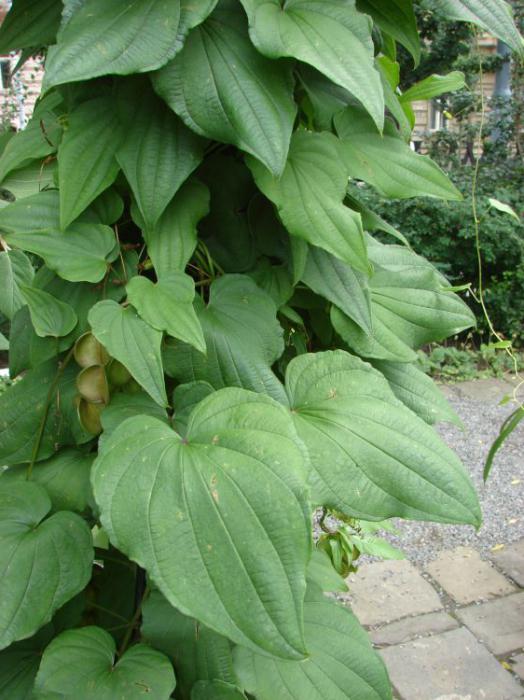

After a stroke, as well as other heart diseases, it is necessary to use the following infusion: take 8 tablespoons of dry, thoroughly crushed root, pour it with 1.5 liters of vodka, and then infuse for two weeks. It is better to add the tincture to hot tea, while just one spoon is enough - in the morning, afternoon and evening. It is necessary to be treated in four courses, while the break should be 1 month.


